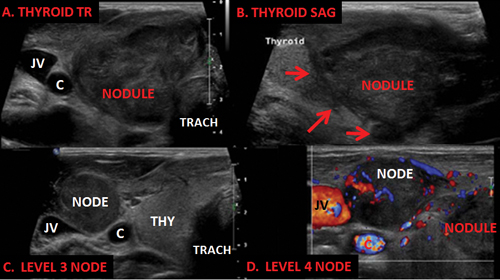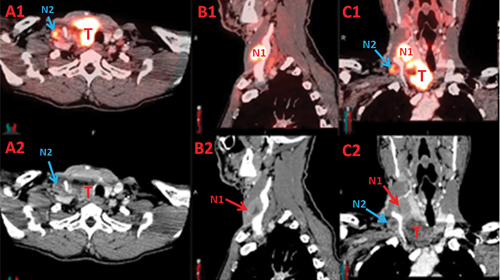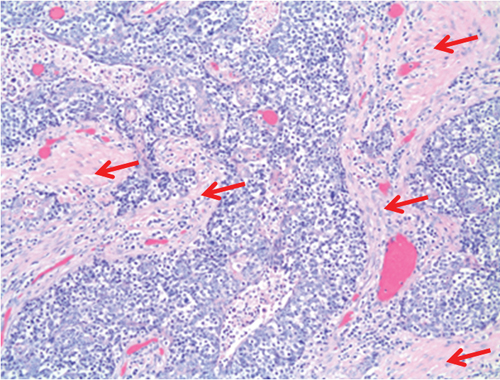CASTLE: Cancer of the thyroid showing thymus-like differentiation
A 65-year-old male was referred to the clinic for a right thyroid mass. The patient noted progressive enlargement of his right neck over the previous 3 months with new onset dysphagia. He had no prior history of thyroid disease or head and neck radiation. He smoked one-third of a pack of cigarettes per day and did not drink alcohol. The patient had no family history of thyroid disease or thyroid cancer. His TSH was normal at 0.95 mIU/mL.
A thyroid ultrasound showed a large 4.9-by-3.3-by-4.8 cm (SAG-by-AP-by-TR) hypoechoic mass in the inferior right lobe of the thyroid (Figure 1). The mass had irregular margins with low-moderate intranodular vascular flow (grade 3-4) without calcifications. There were two rounded 2-cm heterogeneous and enlarged lymph nodes with loss of central hilar fat and increased peripheral vascular flow by Doppler analysis in right levels 3 and 4. An ultrasound guided biopsy of the right thyroid nodule and level 3 node were both consistent with poorly differentiated squamous cell carcinoma.

Stephanie L. Lee
Hypermetabolic mass
A PET/CT was performed that showed a hypermetabolic (SUV Max 17.4) 4.8-by-4.5-by-6 cm mass with a central area of low attenuation consistent with necrosis that extended into the superior mediastinum (Figure 2). There were hypermetabolic lymphadenopathy in the right cervical levels 3 and 4 (nodes 1 and 2, respectively in Figure 2).
The patient underwent total thyroidectomy with central neck dissection, right modified neck dissection and selective left neck dissection showing a 5-by-5-by-5 cm primary tumor in the inferior right thyroid lobe with extracapsular extension and lymph node metastases in right level 3, right level 4 and the anterior mediastinum. The tumor histology showed nests and cords of tumor cells with vesicular nuclei and prominent nucleoli separated by a dense fibrous stroma (Figure 3).
Figure 1. Thyroid ultrasound scan. A hypoechoic mass is located in the inferior lobe of the right thyroid shown in transverse (A) and sagittal (B) views. The mass has an irregular border with evidence of invasion (arrows). Abnormal, round nodes are seen in right lateral neck in level 3 (C) and level 4 (D). The nodes were both rounded with loss of central fatty hilum and increased peripheral vascular flow consistent with metastases (C,D).
Source: Stephanie L. Lee, MD, PhD
Figure 2. PET/CT scan of the neck. The hypermetabolic thyroid tumor (T) in the inferior right lobe is showed in the fused PET/CT scan (top row) and CT scan (bottom row). The axial view is shown in column A, the sagittal neck in column B and the coronal images in column C. The metastatic nodes in right level 3 (N1) and right level 4 (N2) are both hypermetabolic.
Immunoperoxidase studies were positive for P63, CD5 and CEA and negative for thyroglobulin and thyroid transcription factor 1 (TTF-1). The tumor morphology and immunohistochemical profile favors carcinoma showing thymus-like differentiation (CASTLE). He was staged as T4aN1b and was treated with adjuvant concurrent chemoradiation therapy with cisplatinum. Although the patient has had excellent local tumor control, within 7 months of his initial diagnosis, he developed metastatic liver disease with a biopsy showing the same thyroid cancer histology. He is currently clinically stable 3 years after trials of several chemotherapy agents and is currently stable on carboplatin and etoposide.
A rare neoplasm
CASTLE is a rare neoplasm arising from the thyroid which has a histologic and immunophenotypic resemblance to thymic carcinoma. It is classified by some as carcinoma within ectopic thymus tissue or branchiocephalic pouch remnant in the thyroid.
Thyroid CASTLE is recognized by the World Health Organization as an independent clinicopathological entity. The histology is characterized by thick fibrous bands dividing the tumor, many lymphocytes, infrequent mitoses, oval vesicular nuclei with sharply defined nucleoli and immunoreactivity of CD5. Thymomas do not stain for CD5. The sensitivity and specificity for CD5 in CASTLE tumors is 82% and 100%, respectively.
Similar to this patient, other markers besides CD5 are found in CASTLE tumors including high molecular weight keratin, carcinoembryonic antigen and p63. Several tumors of the thyroid including medullary thyroid carcinoma, poorly differentiated thyroid carcinoma (insular), anaplastic thyroid carcinoma and squamous cell carcinoma must be differentiated from CASTLE. All these tumors stain for keratin but only CASTLE will have focal or diffuse immunostaining for CD5.
Calcitonin is positive only in medullary thyroid carcinoma. Thyroglobulin and TTF-1 are positive in insular carcinoma and diffuse sclerosing variant of papillary thyroid and occasionally in scattered cells with anaplastic thyroid carcinoma. Distinguishing thyroid CASTLE from anaplastic thyroid and squamous cell a carcinoma is important as the prognosis of CASTLE is generally more favorable with a more indolent course. The management of patients with CASTLE is limited because of the rarity of this condition but it appears there is better outcome with a total thyroidectomy with central node dissection and external radiation therapy.



